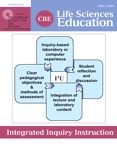Student Learning Outcomes and Attitudes When Biotechnology Lab Partners Are of Different Academic Levels
Abstract
The North Carolina State University Biotechnology Program offers laboratory-intensive courses to both undergraduate and graduate students. In “Manipulation and Expression of Recombinant DNA,” students are separated into undergraduate and graduate sections for the laboratory, but not the lecture, component. Evidence has shown that students prefer pairing with someone of the same academic level. However, retention of main ideas in peer learning environments has been shown to be greater when partners have dissimilar abilities. Therefore, we tested the hypothesis that there will be enhanced student learning when lab partners are of different academic levels. We found that learning outcomes were met by both levels of student, regardless of pairing. Average undergraduate grades on every assessment method increased when undergraduates were paired with graduate students. Many of the average graduate student grades also increased modestly when graduate students were paired with undergraduates. Attitudes toward working with partners dramatically shifted toward favoring working with students of different academic levels. This work suggests that offering dual-level courses in which different-level partnerships are created does not inhibit learning by students of different academic levels. This format is useful for institutions that wish to offer “boutique” courses in which student enrollment may be low, but specialized equipment and faculty expertise are needed.
INTRODUCTION
Peer learning can be considered as encompassing both collaborative and cooperative learning. This style of learning involves students working together toward a common goal. Boud and colleagues define peer learning as “the use of teaching and learning strategies in which students learn with and from each other without immediate intervention of a teacher” (Boud et al., 1999). Peer learning can entail reciprocal peer learning, in which students are both the teachers and the learners. This is in contrast to peer instruction (peer teaching), in which one or more students are designated as teachers (Boud et al., 1999).
Peer learning has been shown to be effective in a wide range of disciplines (Johnson et al., 1981), including biology (Marbac-Ad and Sokolove, 2000). Often, complex biological concepts or problems are presented in class, and engagement in peer learning may facilitate students supplying or acquiring missing information or clarifying misconceptions. Instructors may also choose to implement peer learning to take advantage of different viewpoints and backgrounds among peers that can help foster problem-solving approaches not seen when students work individually (Congos and Schoeps, 1998).
Laboratory courses represent an academic setting in which peer learning is most often useful. In the North Carolina State University (NCSU) Biotechnology Program, most of our laboratory courses require that students work as partners. Aside from alleviating space and budgetary concerns, this arrangement provides students with a learning environment that fosters peer learning. Students must submit individual laboratory reports, but experimentation, data collection, and analysis of the results are a joint effort. Previous research into peer instruction in a general chemistry laboratory course involved advanced undergraduates who had successfully completed the course leading small groups of other undergraduates (McCreary et al., 2006). This Workshop Chemistry model resulted in enhanced student learning relative to students who participated in conventional chemistry labs. Similarly, students in a veterinary parisitology lab course that implemented peer learning indicated that the group work enhanced their understanding of the material (Monahan and Yew, 2002).
Cooperative learning in heterogeneous student populations has perhaps been most thoroughly described in K–12 settings (Cohen et al., 1995, 1999; Cohen and Lotan, 1997; Boaler, 2006). These studies, however, focused on students who differed in academic ability, linguistic ability, ethnicity, and/or economic background. In higher education, reports on peer learning among students of different academic levels have been published (Johnson et al., 1981). For example, the Peer Assisted Learning (PAL) program has been implemented in an undergraduate hospitality course in which second-year students served as student leaders who facilitated group discussions among first-year students (Capstick and Fleming, 2002). The second-year students had already successfully completed the course, so this use of peer instruction aimed at enhancing critical thinking among the first-year students only. Similarly, PAL has been applied in a clinical lab skills course in a peer instruction format (Weyrich et al., 2008).
Almost all of our biotechnology courses are offered as dual-level courses to both undergraduate and graduate students (Miller et al., 2009; Witherow and Carson, 2011). Students of both academic levels are often in the same sections of both lecture and lab; they are required to work as partners in the lab component. From a practical standpoint, all students serve to benefit from practice in these lab techniques. Furthermore, as these courses require a large amount of specialized molecular biotechnology equipment, grouping undergraduates with graduate students in one section allows more students per semester to gain exposure to the equipment (Carson et al., 2009).
Instructors often struggle with the decision of whether to allow students to select their own partners or to assign partners. If instructors choose to assign partners, a number of different criteria can be applied when determining partners or groups (Wright and Boggs, 2002). In these dual-level courses, in which students are free to choose their partners, we have observed that undergraduate students prefer to work with other undergraduate students and graduate students prefer to work with other graduate students (same academic level; unpublished data). However, retention of main ideas in a peer learning environment has been shown to be greater when partners have dissimilar abilities (Larson et al., 1984). To our knowledge, there are no published reports on learning outcomes in a peer learning environment with lab partnerings consisting of one undergraduate and one graduate student (different academic levels). Therefore, we tested the hypothesis that there will be enhanced student learning when lab partners are of different academic levels, as compared with student learning when lab partners are of the same academic level.
METHODS
Student Demographics
All students were enrolled in a course entitled “Manipulation and Expression of Recombinant DNA” (Carson et al., 2012). Out of 170 students, two were nonmatriculated. Assessment data from these two and their two partners were not included, because they could not be clearly defined as undergraduate or graduate students. Students enrolled in this course on a first-come, first-served basis and were required to enroll in both the lecture and laboratory components. The prerequisites for undergraduate students were a freshman-level biology course, two semesters of general chemistry, and two semesters of organic chemistry. No specific prerequisites were required of the graduate students, but the vast majority had significant prior course work. The data were collected from three sections during Fall 2010 and two sections during Spring 2011. Based on applicable survey responses (n = 140; see Results below), 83 were undergraduate students (all juniors and seniors) and 57 were graduate students (12 thesis master's, 12 nonthesis master's, and 33 PhD students). For the purposes of this study, the different types of graduate students were not delineated; all 57 were classified as graduate students. The three sections in the Fall represented the control groups, in which undergraduate and graduate students enrolled in separate sections of both lecture and lab. The two sections in the Spring represented the experimental groups, in which students at both academic levels could enroll in either section. The instructor deliberately assigned laboratory partners, so that as many undergraduate–graduate pairs as possible could be formed.
Instructor Information
The three Fall sections were taught by H.B.M., D.S.W., and S.C., while the two Spring sections were taught by H.B.M. and D.S.W. Each instructor had taught the course at least two times in the past. H.B.M. has a BS in molecular biology/biotechnology and a PhD in molecular genetics and microbiology. She is a teaching postdoctoral fellow in the NCSU Biotechnology Program. D.S.W. has a BA in chemistry and a PhD in molecular and cellular pharmacology. At the time of the study, he was also a teaching postdoctoral fellow. S.C. has a BS in biotechnology and a PhD in microbiology. She is a teaching associate professor and academic coordinator of the NCSU Biotechnology Program. Instructors used the same lecture materials and assessment methods. All laboratory protocols were the same. Each instructor had two graduate teaching assistants each semester who primarily instructed the laboratory component. Four different teaching assistants were utilized in this study, and three had at least one section in both the Fall and the Spring. Each was made aware of the study being conducted and contributed to the study by distributing student surveys and facilitating Learning Cell activities (see section on this topic).
Course Synopsis
This laboratory-intensive course had a 2-h lecture period and 5-h laboratory period, both of which met on a weekly basis for 16 wk. The details of the laboratory content were previously described (Carson et al., 2012). Briefly, students were exposed to essential molecular biotechnology techniques and the scientific theories behind them. The course used a semester-long cloning and protein expression project to impart conceptual and technical skills. Among the laboratory techniques utilized were plasmid DNA purification, restriction digestion, agarose gel electrophoresis, cloning by polymerase chain reaction (PCR), monoclonal antibody screening, PCR screening, Western blotting, and affinity chromatography. All students worked in pairs in the laboratory.
Student Learning Outcomes of the Course
Expectations for students who enrolled in this course were clearly described in the syllabus, which included a list of student learning outcomes.
On completion of the course, students will be able to:
explain how to manipulate DNA to create new proteins;
perform a variety of techniques in the manipulation of recombinant DNA and protein expression;
evaluate data and controls related to gene cloning and protein expression;
troubleshoot experiments that do not work;
create thought-provoking questions related to the laboratory material; and
synthesize a strategy for cloning a gene of interest and expressing and purifying the protein (graduate students only).
Learning Cell Activities
To enhance the peer learning environment in the laboratory, activities based on the Learning Cell (Goldschmid, 1971; Goldschmid and Shore, 1974) were implemented in all sections. These activities refer to a cooperative learning technique used among partners. Briefly, as part of each week's prelab assignment, students were asked to individually create a thought-provoking question related to that week's laboratory exercise. According to Webb's model (Webb, 1989), students were expected to ask questions that might elicit elaborate replies in order to enhance achievement. Low-level elaboration was discouraged, as these were found to be detrimental to learning. An example of a low-level question would be “What polymerase will we add to the PCR reactions?” Therefore, only higher-order questions based on the application, analysis, and evaluation levels of Bloom's taxonomy of thinking (Bloom, 1956) were awarded credit. An example would be “Why do we use DNA polymerases isolated from thermophilic bacteria in PCR?” If the question was omitted or required only lower-order thinking skills to answer, the instructor deducted 10 points from the prelab assignment. Each instructor reviewed these questions the day of the laboratory and selected two or three Learning Cell questions to open up for discussion during the lab. Students whose questions were selected received 1 bonus point on the final exam. Multiple bonus points could be accumulated.
During downtime in the lab (e.g., during a 30- to 60-min incubation), students were encouraged to discuss answers to the chosen Learning Cell questions with their lab partner and surrounding peers. Each student had to record an answer in his or her lab notebook and obtain the teaching assistant's signature once it was completed. Assistants were instructed not to provide students with answers, only to help direct students who asked for clarification. A previous study has shown that combining instructor explanation with peer discussion improved student performance compared with either alone (Smith et al., 2011). Therefore, the next time the class met for lecture, instructors again opened up the questions for discussion. Students volunteered their answers, and the instructors expanded on and clarified any material, as needed.
Assessment Methods
To determine whether student learning outcomes were met, several assessment methods were used. Prelab assignments consisted of two parts: the Learning Cell question submission (see preceding section), and a section containing multiple-choice, true/false, or short answer questions. The Learning Cell question submission assessed the higher-level learning outcome 5, and the section containing multiple-choice, true/false, or short answer questions assessed the lower-level learning outcome 1 and was used as incentive for students to read and understand the laboratory protocol before class. These prelab assignments constituted 12.5 and 10% of undergraduate and graduate students’ overall grades, respectively.
Laboratory notebooks and four laboratory reports were completed by each individual student and assessed student learning outcomes 1, 2, 3, and 4. Laboratory notebooks constituted 7.5% of both the undergraduate and graduate students’ overall grades. The first laboratory report constituted 2.5% of both the undergraduate and graduate students’ overall grades. The second, third, and fourth laboratory reports each constituted 7.5 and 5% of undergraduate and graduate students’ overall grades, respectively.
Two take-home exams were administered during this course; these also assessed student learning outcomes 1, 2, 3, and 4. Ten essay questions were included that were worth 10 points each. Partial credit was awarded. Students were encouraged to form peer study groups to work on these exams. Example questions from each of the take-home exams are included in the Supplemental Material. Each take-home exam constituted 15% and 12.5% of undergraduate and graduate students’ overall grades, respectively.
The final exam was a cumulative, closed-book assessment of student learning outcomes 1, 2, and 3. Question formats were multiple choice, true/false, matching, and fill-in-the-blank, and one experimental design question was also included. Many of these questions involved higher-order thinking skills. For example, students were asked to design PCR primers, determine reading frames, and perform various calculations. The final exam constituted 20 and 15% of undergraduate and graduate students’ overall grades, respectively.
Graduate students who enrolled in this course were expected to complete an additional assignment on experimental design. They had to choose a gene of interest, research its function and importance, justify the purpose for purifying it, design a PCR-based cloning strategy to clone it into an expression vector, and describe the methods for expressing and purifying the protein. This paper assessed student learning outcomes 1, 2, 3, and 5, and constituted 20% of graduate students’ overall grades.
Finally, a participation grade was earned that included laboratory and classroom citizenship, punctuality, participation, and lecture attendance. This constituted 5% of each student's overall grade in the course. Statistical significance of assessment method outcomes was calculated with an unpaired Student's t test.
Anonymous Survey
During the last lab session, students had the option to complete an anonymous survey. Participation was not required. Surveys were given number and letter designations before they were handed out, so that students who were lab partners could be identified, while actual names could not. Both lab partners had to complete a survey for the data to be included in the study. We did not use survey data from 26 students who had a partner who did not complete the survey, or who came from undergraduate–undergraduate partners in the semester in which most partners were of different academic levels. Surveys from nonmatriculated students and their partners (four surveys) were also discarded, leaving data from a total of 140 surveys (82% of the possible 170 surveys). Students were asked to supply demographic information and synopses of their past research and lab experiences, and to relate their attitudes on working with partners, opinions of the Learning Cell activity, and perceptions of how confidently they could apply certain skills (both higher- and lower-level thinking skills and technical skills). Statistical significance of students’ perceptions from the surveys was calculated by chi-square tests. Approval to evaluate students by an anonymous survey (exempt status) was granted by the Institutional Review Board, NCSU. The complete survey is included in the Supplemental Material.
RESULTS
Learning Goals Were Met by Students of Both Academic Levels, Regardless of Lab Pairing
In this dual-level course, many students from a wide variety of disciplines gained hands-on experience in molecular biotechnology. Of the 140 students surveyed, 59.3% were undergraduates, 23.6% were PhD students, 8.6% were thesis master's students, and 8.6% were nonthesis master's students (Figure 1A). The variety of majors and degree-granting programs that students came from illustrates the far-reaching applicability of skills gained in this course (Figure 1B). Students in biological sciences and chemical engineering made up the majority of participants in the study, but many other disciplines in the life sciences, physical sciences, and engineering were also represented. Of note, biological sciences and chemical engineering are both majors with very high enrollment at the university; the number of students from these majors does not necessarily indicate that a higher percentage of students in these majors take this course compared with the percentage of students in other majors.
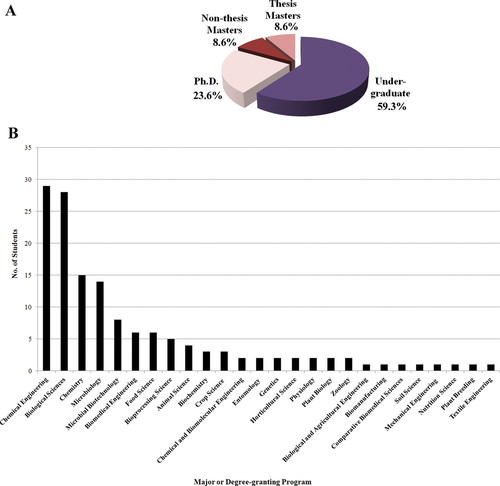
Figure 1. Student demographics. (A) Students were categorized based on the degree toward which they were currently working: nonthesis master's, thesis master's, and PhD students were also grouped together as graduate students in this study. (B) Students were categorized based on the major or degree-granting program with which they were associated.
In Fall 2010, separate sections of the course were dedicated to either undergraduate or graduate students. In this way, laboratory partners assigned at random were certain to consist of either two undergraduate students or two graduate students. In Spring 2011, each section contained both undergraduate and graduate students. Laboratory partners were assigned to ensure that as many pairs as possible would consist of one undergraduate and one graduate student. In this report, student pairs will be described as “same” pairs or “different” pairs with respect to the academic levels of the students. The four groups compared consisted of “undergraduate same,” “undergraduate different,” “graduate same,” and “graduate different.” A number of methods were in place to assess student learning (see Methods).
In all assessment methods, graduate students earned higher grades than undergraduate students when same pairs were compared (Figure 2). All grades showed statistically significant differences, except for the laboratory notebook grade. When comparing the types of laboratory pairings, undergraduate students in different pairs performed better on average than undergraduate students in same pairs across all assessment methods. Average lab report grades of undergraduates in different pairs showed a statistically significant increase (p < 0.05) compared with grades of undergraduates in same pairs, although this change was not necessarily meaningful (see Discussion).
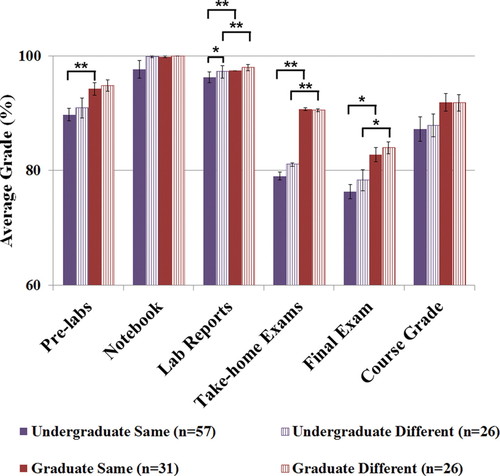
Figure 2. Summary of assessment results. Data shown are average grades earned by either undergraduates paired with other undergraduates, undergraduates paired with graduate students, or graduate students paired with other graduate students. Error bars represent the SEM. Statistical significance was calculated by a Student's t test. *p ≤ 0.05, **p ≤ 0.01. Statistical significance was not calculated for the course grades because graduate students completed an additional assignment. Therefore, assessment methods were weighted differently between undergraduate and graduate students in calculating the course grades.
To further examine the method that particularly assessed higher-level thinking skills, we examined results of the two take-home exams (one taken halfway through the semester and the second taken at the end of the semester); this information is presented in Figure 3. Whereas undergraduate and graduate students in same pairs did not earn higher grades on take-home 2 compared with take-home 1, undergraduate and graduate students in different pairs did earn higher grades on take-home 2 (Figure 3, A and B). It should be noted that subject material on take-home 1 was different from that on take-home 2. Regardless of whom students were paired with in the laboratory, these assessment results indicate that student learning goals were met. Furthermore, the vast majority of assessments demonstrated increased grades, rather than unchanged or decreased grades. This supports the idea that the pairing of undergraduate and graduate students was mutually beneficial.
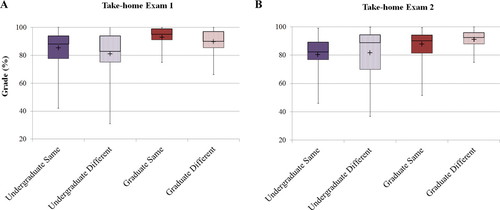
Figure 3. Take-home exam results. Box-and-whisker plots show the first and third quartile of each individual assessment method. The horizontal line in each box represents the median, and the plus sign represents the mean. Error bars represent the range of student results. Statistical significance was calculated by a Student's t test. *p ≤ 0.05, **p ≤ 0.01. (A) Take-home exam 1 and (B) take-home exam 2 results of undergraduates paired with other undergraduates, undergraduates paired with graduate students, or graduate students paired with other graduate students.
Student Attitudes toward Working with Others Shifted Dramatically
The anonymous surveys completed at the end of this course offered insight into how students perceived working with others in a laboratory setting. For space, budgetary, and educational purposes, students enrolled in this course were required to work as partners. However, students who had worked in same pairs responded on the survey that they generally preferred to work on their own (Figure 4A). Only 23–31% of students in different pairs either strongly agreed or agreed that they preferred to work on their own, as opposed to 44–51% of students in same pairs. While differences in responses between undergraduate and graduate students or between same and different pairs are meaningful, we could not show them to be statistically significant due to the differences in sample sizes among groups.
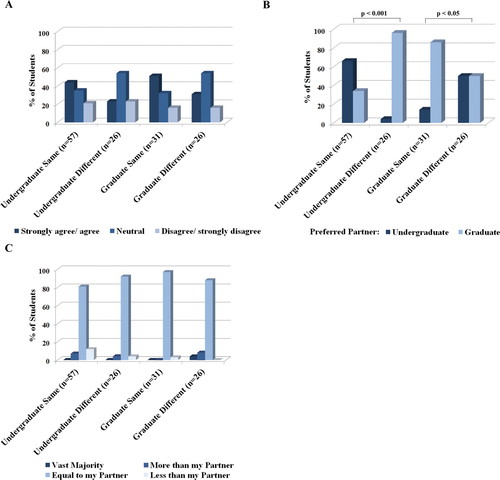
Figure 4. Student perceptions about working with peers. Statistical significance between same and different pairs was determined with a chi-square test. (A) Students rated how strongly they agreed or disagreed with the following statement: “I prefer to work on my own.” (B) Students chose the academic level of their preferred laboratory partner. (C) Students responded to the following question: “How much did you contribute to your station's work?”
In previous semesters, students were allowed to choose their own partners. Evidence from this course and other dual-level courses in the Biotechnology Program pointed to a student preference for a lab partner of the same academic level. To address this perception, students were posed a question regarding their preferred laboratory partner. Consistent with previous observations, students of both academic levels (in same pairs) said they preferred a laboratory partner of the same academic level (66% of undergraduates and 86% of graduate students; Figure 4B). However, surveys from students who had completed the course as part of a different pair showed a reversal in this attitude. Only 4% of those undergraduates preferred to work with someone of the same academic level (p < 0.001). This attitude shift also extended to graduate students, of whom only 50% preferred to work with someone of the same academic level (p < 0.05).
One concern at the onset of this study was that pairing undergraduate and graduate students could result in the graduate student contributing more to the partnership than the undergraduate. To survey students’ perceptions of their contributions, as well as their partners’ contributions, surveys were coded so that partners’ responses could be compared as a set without revealing individual names (see Methods). The vast majority of students, regardless of academic level or pairing, reported that their contribution was equal to that of their partner (Figure 4C). Only 7% of all student pairs included a response that one member contributed more or less than the other; however, all of these students were in agreement as to who contributed more. A small number of student pairs were not in agreement: 6% included a response that they contributed an equal amount, while the partner responded that those students contributed less. Finally, 6% included a response that they contributed an equal amount, while the partners responded that those students contributed more.
All of the undergraduates enrolled in this course were advanced, with the majority being seniors. The graduate students, who were mainly in their first 2 years of graduate study, can be considered their peers, as they were similar in academic level. To validate the notion that pairing undergraduate and graduate students represented a truly heterogeneous pairing (that is, do the graduate students really possess abilities different from those of the undergraduate students?), we surveyed students on their research experiences and previous molecular biology lab experiences. Research experiences were much more common among graduate students. Fifty-five percent of undergraduates surveyed had participated in research, while 82% of graduate students had (p < 0.001; Figure 5A). It should be noted that these previous experiences were not limited to those relevant to the course. Furthermore, when asked about the duration of these research experiences, only 39% of undergraduate students with research experience responded that the duration was a year or more, while 82% of graduate students with research experience had a year or more of experience (p < 0.001; data not shown). The majority of undergraduates had some exposure to molecular biology skills, as 64% (n = 83) responded that they had some previous molecular biology lab experience (Figure 5A). Sixty-seven percent (n = 57) of graduate students responded the same way (p < 0.001). Together, these results demonstrate that the graduate students in this study had more general lab-related experiences as a whole compared with undergraduates prior to enrolling in this lab-intensive course, especially in terms of exposure to research.
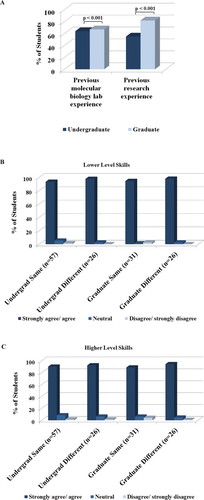
Figure 5. Student experience and perceived skills. (A) Students responded as to whether they had previous molecular biology lab experience and research experience. Statistical significance between undergraduate and graduate responses was calculated with a chi-square test. (B) Students rated how strongly they agreed or disagreed with the following statement: “Presently, I can…” Five lower-level thinking skills were listed: successfully follow lab protocols, accurately pipette 2 μl of liquid, prepare and run an agarose gel, design PCR primers to amplify a gene of interest, and perform a small enzymatic reaction. (C) Five higher-level thinking skills were listed: draw logical conclusions from results obtained, troubleshoot experiments, describe lab work in a clearly written report, communicate effectively with a lab partner, and successfully design and implement a cloning strategy. Average percentage of each response among either lower- or higher-level skills is shown.
We next investigated students’ perceptions of their ability with respect to a series of skills. These skills included not only technical skills, but conceptual skills directly related to student learning outcomes. These items were also classified based on the level of thinking skills required to complete the item. Comparison of student responses from those in same versus different pairs clearly indicated that different pairs reported slightly higher gains in both lower- and higher-level thinking skills (Figure 5B). This held true for both undergraduate and graduate students. The perceived increases in higher-level skills were not statistically significant.
Discussing Learning Cell Questions Was Perceived as More Beneficial Than Creating Them
Finally, feedback on the Learning Cell activities was obtained through three additional survey responses. The first statement said: “Discussing answers to the Learning Cell questions with my classmates increased my understanding of the course material.” The majority of students, regardless of academic level or pairing, responded that they strongly agreed or agreed with that statement (Figure 6A). The second statement said: “Creating my own Learning Cell questions increased my understanding of the course material.” In contrast with statement 1 responses, a significantly smaller fraction of students (all levels and pairings) responded that they strongly agreed or agreed (p < 0.001; Figure 6B). Students who were part of a different pair responded slightly more positively to both discussing and creating Learning Cell questions, compared with students who were part of a same pair; however, this difference was not statistically significant.
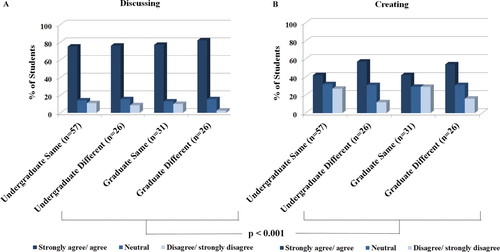
Figure 6. Student perceptions of Learning Cell activities. (A) Students rated how strongly they agreed or disagreed with the following statement: “Discussing answers to the Learning Cell questions with my classmates increased my understanding of the course material.” (B) Students rated how strongly they agreed or disagreed with the following statement: “Creating my own Learning Cell questions increased my understanding of the course material.” Statistical significance between discussing and creating questions was determined with a chi-square test.
The third survey response pertaining to Learning Cell questions was an opportunity for students to supply additional comments or suggestions. Two students responded negatively:
“I actually tried to develop some good questions that could not easily be answered by looking at class notes or lab notebook. NONE were chosen.”
“Everyone deserves credit.”
Other comments also reflected the idea that this activity was viewed only as a chance for earning extra credit:
“Give more extra credit for each question, and give bonus to students who figure out the question without assistance.”
“The only thing good about them is that they were worth extra credit points. Otherwise, I feel like it was just busy work.”
However, many students did provide comments that showed that they valued the Learning Cell activities:
“Learning Cell questions definitely make us talk about biotechnology and is a good writing/thinking strategy.”
“Great set up. I like that we get to both write and answer the questions, it really helps us to get involved.”
“It was a good addition to the course and a nice way to earn a little extra credit. I would keep it going.”
Finally, a formal course evaluation at the end of the Spring 2011 semester contained a particularly interesting comment from an undergraduate student that reflected the instructors’ hopes for this course:
“I heard that this was the first semester of having both graduate students and undergraduates together in the same class. I enjoyed having grad students and undergrads in the same class, and I certainly learned a lot from the graduate students who do this kind of lab work every day. For me it was a great learning experience. (I wonder if the grad students got as much out of it as we did.)”
DISCUSSION
This course on manipulation and expression of recombinant DNA aimed to provide both undergraduate and graduate students with experience in core molecular biotechnology techniques. The laboratory-intensive nature of this course provided a favorable setting for studying peer learning among laboratory partners. We set out to determine whether student learning was enhanced when lab partners were of different academic levels compared with lab partners of the same academic level.
To assess student learning, a number of methods were applied, including prelab assignments, lab notebooks, lab reports, take-home exams, and a final exam. Examining the traditional, same-level laboratory pairs showed that graduate students earned higher average scores on all assessment methods. Pairing students of different academic levels showed that both undergraduate and graduate students earned higher grades, on average, in most assessments (Figure 2).
Although average lab report grades of undergraduates in different pairs showed a statistically significant increase (p < 0.05) compared with grades of undergraduates in same pairs (Figure 2), we are not convinced that this is meaningful. Four different teaching assistants were responsible for grading lab reports, and the vast majority of report grades (96%) ranged from only 90 to 100%. Therefore, it is unclear that teaching assistants utilized the full range of grades or sufficiently differentiated the lab reports qualitatively.
Regardless of lab partner pairing, both undergraduate and graduate students met their learning outcomes. Our findings show that the practice of pairing undergraduate students with graduate students in the lab does not greatly enhance student learning, but it does not inhibit learning of students of different academic levels. Therefore, we argue against the need to have separate sections for undergraduate and graduate students. Universities that adopt the laboratory section arrangement presented here will not need as much classroom and laboratory availability. Combining advanced undergraduates and graduate students in a single class is useful for institutions that wish to offer specialized “boutique” courses in which student enrollment may be low, but specialized equipment and faculty expertise is needed.
Survey responses concerning the Learning Cell activities revealed that most students perceive discussing the answers to the questions with their peers, teaching assistants, and instructors as improving their understanding of the course material. Because creating a thought-provoking question involves higher-level thinking skills, we found it interesting that many of the students did not view this part of the activity as beneficial. This perception may not have accurately reflected actual student learning, although an answer to that is outside the scope of this study. Another possibility is that fewer students liked generating the questions, because that took more effort than simply answering questions. Questions were submitted by individuals, not peer learning groups. It is also likely that some students’ negative responses to this activity reflected that none of their questions were chosen for class discussion, and therefore, they received no bonus points. Of the 25 optional comments submitted on the survey, two alluded to this (see Results).
Awarding bonus points to high-quality questions was chosen as a motivator to ensure that fewer students would submit a recall question that could simply be answered by looking in the lab manual. It would be interesting to repeat this without awarding bonus points to determine whether attitudes shifted. Because discussing answers to these questions was viewed very favorably, we are continuing this portion of the activity in our course. However, we are employing student-generated questions from this study, rather than asking students to design new questions each semester.
The most striking results in this study were drawn not from student grades, but from student responses on the survey concerning working with their peers. Not surprisingly, almost 40% of students, regardless of academic level, preferred to work on their own. Many times, prior experiences in class group work have shaped students’ attitudes toward working with others. These attitudes are not always positive. However, students who worked in different pairs (regardless of academic level) reported less of a preference for working on their own, compared with students who worked in same pairs. This is encouraging, as students will continue to work with others on a daily basis, not as isolated individuals, in their scientific careers.
At the onset of this study, it seemed likely that undergraduates would favor working with a more advanced student who could help guide, and in some ways, mentor them. It was somewhat surprising that even graduate students viewed working with undergraduates very favorably. These perceptions of working with peers validated the notion that peer learning, as it was applied here, is indeed mutually beneficial. Graduate students, many of whom may have aspirations to serve as principal investigators and/or instructors, can seize this opportunity in the biotechnology lab to help a fellow classmate and even shape his or her view of scientific research. Above all, these graduate students are solidifying the concepts addressed in the course through discussing answers to the Learning Cell questions and describing other steps of the laboratory exercises to the undergraduates. Research has shown that individual student achievement levels are positively related to giving explanations to others in a small group setting (Webb, 1989). Teaching can be an effective way to solidify one's own knowledge. So, even though graduate students enter this class with more advanced laboratory and research skills (Figure 5) and can complete the laboratory exercises on their own, many would still choose to work with an undergraduate. Furthermore, the undergraduates are getting feedback on their technical and conceptual skills not only from the instructors and teaching assistants, but also from their lab partners. At this stage of their careers, undergraduates will soon be entering the workforce or graduate school. They will be required to work with others as members of learning communities that consist of individuals more (and less) advanced than they are. The involvement of peer learning with students more academically advanced during their undergraduate careers can only benefit their education.
If this study were to be repeated, it might be valuable to assign no bonus points in the Learning Cell activities. One could then gain insight into whether students’ negative perceptions of creating their own questions were really due to not having their questions selected and not earning bonus points that they felt they had earned. It would also be interesting to poll students on previous experiences working in a team and whether they worked with same- or different-level peers, although it is likely that for many students this course was the first dual-level laboratory course in which they had enrolled. Information gained from the survey could also be strengthened by adding open-ended questions on student perceptions of pairs of different academic levels. Finally, we are continuing to investigate peer learning in this dual-level course by keeping the different pairs format and studying any enhancement in higher-order thinking skills. In particular, we aim to determine whether students of different academic levels working on team take-home exams results in enhancement of overall student learning outcomes.
FOOTNOTES
Potential conflict of interest: The authors are also the authors of Molecular Biology Techniques: A Classroom Laboratory Manual, which is used in the course described in this manuscript. No promotion of this book to the exclusion of other books should be construed.
ACKNOWLEDGMENTS
We thank the NCSU Biotechnology Program and the Office of Faculty Development for their support of this project. We also thank the teaching assistants, Lissete Betancur, Luyan He, Aydin Beseli, and Soundarya Srirangan, for their support; participating students for useful feedback; Melissa Cox for preparing the laboratories; Devon Viscount for contributions to the data analysis; and Dr. Consuelo Arellano for statistical consultation.


